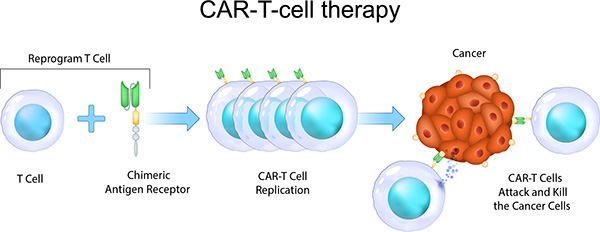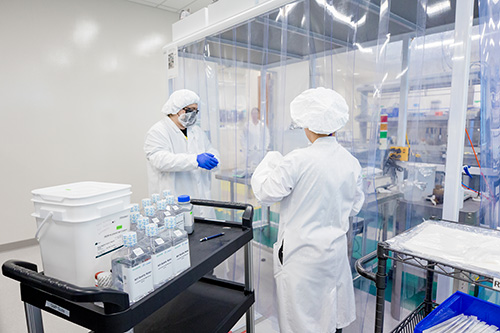Importance of a Chemically Defined Workflow for ATMP Product Quality and Safety
Introduction
Advanced Therapy Medicinal Products (ATMPs), which include Cell and Gene Therapy (C>) drug products, must adopt safe, controllable, traceable, and reproducible development and manufacturing practices. This allows them to seamlessly transfer to an Investigational New Drug (IND) application and/or clinical trials. Incorporating raw materials that comply with regulatory requirements for ATMP manufacturing is critical as an early control, helping to avoid regulatory body delays and facilitate technology transfer. However, biomanufacturers face challenges when it comes to the raw material qualification process1.

First and foremost, a distinction between ‘starting materials’ and ‘raw materials’ must be made. Starting materials are human or non-human cells and tissues used in the manufacturing of ATMPs that are intended to be in the final product. Raw materials are reagents, materials, or components used in the manufacturing process that may exert effects on, but are not intended to be part of, the final therapeutic product1. In the US, raw materials are sometimes referred to as ancillary reagents.
The process of qualifying raw materials is central to achieving quality and maintaining consistency and controllability in the final intended ATMP. But this can be especially difficult when raw materials are derived from animal sources, including human, as these are inherently inconsistent in identity and integrity. The supply of biologically-sourced raw materials can also be limited or unreliable. Overall, these issues can lead to variable performance, in turn leading to lot-to-lot variability as well as unwanted costs. Finally, failure to properly address variability can result in lack of a consistent and controlled workflow, ultimately impeding progress in therapies over time2. Adopting a chemically defined (CD) workflow mitigates these challenges and provides a tailored approach to achieving a traceable, reproducible, and controlled ATMP development and manufacturing workflow.
In this blog, we discuss what a CD workflow entails and the benefits that pharmaceuticals and biotechnology are reaping when they transition to a CD workflow.
Risks of Traditional Culture Media
Cell culture media is an example of a critical and complex raw material that is central to the success of a potential ATMP or C> drug product as it progresses through the discovery, development, and manufacturing continuum. In addition to driving cell fitness and function, cell culture media and associated supplements play an important role in contributing to the reproducibility challenges the biomedical field faces3. These challenges arise when biomedical manufacturers employ ill-defined supplements, such as serum or serum derivatives like fetal bovine serum (FBS) or human AB serum, for key cell culture and manipulation steps in the workflow. Traditionally, biomedical manufacturers included serum or serum derivatives because these supplements provide a complex mix of vital nutrients and other factors that enhance survival, activation, and growth of cells. Use of serum, however, comes with unwanted costs and risks because serum includes undefined components, nitrogenous waste products, and could be influenced by donor-specific characteristics such as gender, age, diet, and underlying health issues. Serum also comes with risks to end-users due to the potential for pathogens. In addition, differences between serum batches is a major source of variability, resulting in additional time and labor costs to end-users having to test and qualify each lot to ensure performance3.
All of the aforementioned issues with animal- or human-derived materials call for a transition to animal component-free or CD substances and methods. One hindrance, however, is the current lack of governance surrounding the labeling of raw materials, where a variety of terminology for raw material quality exists. For the matter of this discussion, we define a number of key terms as follows:
- Serum-free: The formulation does not contain serum.
- Carrier-free: The formulation does not contain bovine serum albumin (BSA) or other equivalent carrier proteins.
- Xeno-free: The product or formulation does not contain any non-human, animal-derived components.
- Animal component-free: The product is manufactured or formulated using raw materials that are certified to not contain any animal, including human, derived products. At no point are final products and production processes exposed to or contaminated with animal-derived products or ancillary by-products. Products are manufactured using dedicated animal component-free vessels.
- Chemically defined (CD): The product or formulation contains only known, chemically pure components or substances. The product or formulation may contain proteins of recombinant-origin that were expressed in well-characterized, controlled expression systems. The final product contains, or used in its manufacturing processes, raw materials that have a known chemical structure and concentration (e.g. small molecules, salts, carbohydrates, amino acids, fatty acids, steroids, etc.).
Media reagents that are serum-free replace human serum for cell culturing, thereby avoiding safety risks and variability between product lots while ensuring product consistency. As the number of ATMP or C> products being developed grow, the potential for these therapies to be translated into the clinic is pushing the industry to adopt safe and reproducible cell culture systems. Among best practices, regulatory experts recommend to biomanufacturers to use animal-derived component-free (ADCF) or chemically defined (CD) raw materials, procured from safe and traceable sources4,5.
Benefits of Transitioning to a Serum-Free, Chemically Defined Workflow
The key advantage of a CD workflow is that it offers precise knowledge of the nature and quantity of ingredients that go into raw materials, thus removing the issue of variability between batches6,7 while providing a reliable supply line.
Key components of a CD workflow entail the following: first, a defined media in which components, including nutrients, salts, vitamins, and growth factors, are precisely specified and manufactured. Second, in bioprocessing, the cells are cultured in controlled environments with known conditions, allowing for precise monitoring and optimization. And third, all chemical reagents used in the production process, such as buffers and stabilizers, are chemically defined, reducing variability between batches and ensuring product consistency.
Cell therapy manufacturers undoubtedly face challenges when transitioning to a CD workflow. The transition will require initial investments in infrastructure and training of personnel. A series of optimization steps will be necessary: are CD reagents for cell culture available for a particular cell line and have the reagents been evaluated for that cell line? Most likely, the CD media will require optimization for specific cell types and experimental approach3.
However, biomanufacturers that pass these initial hurdles and transition to a CD workflow reap long-term benefits regarding product consistency and process control. Since the nature and quantity of components are precisely known, the risk of introducing contaminants or impurities is greatly reduced, leading to enhanced product quality. In addition, CD media and reagents allow for better process control and optimization, resulting in increased yield, reduced variability, and faster development timelines. As regulatory agencies tighten standards, adhering to a CD workflow helps manufacturers meet requirements more effectively, expedite the approval process, and reduce the risk of costly regulatory setbacks. And, finally, a CD workflow is scalable, making it possible to transition to large-scale manufacturing without significant modifications4,5.
Conclusion
There is an industry-wide initiative to transition towards CD raw materials in the ATMP/C> supply chain where possible. This allows for better predictability of product performance since CD materials are well-characterized and have a consistent composition, ideal for GMP production. Transitioning to a CD cell culture workflow leads to improved control of processes and quality of products, as well as scalability, making large-scale GMP manufacturing possible to support transfer to pre-clinical and clinical applications to commercial manufacturing.
About BioLegend
BioLegend is a leader in the field accelerating research and discovery by providing high-quality GMP recombinant proteins, functional antibodies, and cell culture reagents for ex vivo cell processing and downstream applications. BioLegend is ISO 13485:2016 certified. As such, our GMP products come with quality documentation and full traceability, under independent Quality Assurance oversight. Drug master files are available for many of the GMP products to help manufacturers with regulatory filings.

References
- Bhattacharya, Sam, and Aparna Telang. “Manufacturing and Qualification Challenges for Cell and Gene Therapy Products and Best Practices for Success.” Cell Culture Dish, BioLegend, 6 Mar. 2023, https://cellculturedish.com/manufacturing-and-qualification-challenges-for-cell-and-gene-therapy-products-and-best-practices-for-success/.
- Ghassemi, Saba et al. “Enhancing Chimeric Antigen Receptor T Cell Anti-tumor Function through Advanced Media Design.” Molecular therapy. Methods & clinical development vol. 18 595-606. 9 Jul. 2020, doi:10.1016/j.omtm.2020.07.008. PubMed.
- Weber, Tilo et al. “Case Studies Exemplifying the Transition to Animal Component-free Cell Culture.” Alternatives to laboratory animals : ATLA vol. 50,5 (2022): 330-338. doi:10.1177/02611929221117999. PubMed.
- Ping Lim, Shok, and Sakina Gooljar. “Challenges in qualification & management of raw materials in advanced therapy medicinal products.” Cell and Gene Therapy Insights, vol. 8, no. 2, 2022, pp. 269–277, https://doi.org/10.18609/cgti.2022.043.
- Lebrun, Anne-Sophie, and Carmen Brenner. “Master atmp processes by controlling raw and starting material.” Cell and Gene Therapy Insights, vol. 7, no. 02, 2021, pp. 265–271, https://doi.org/10.18609/cgti.2021.034.
- Scott, Michael et al. “Transitioning from development to commercial: risk-based guidance for critical materials management in cell therapies.” Cytotherapy vol. 22,11 (2020): 669-676. doi:10.1016/j.jcyt.2020.06.011. PubMed.
- Jayaraman P, Lim R, Ng J, Vemuri MC. Acceleration of Translational Mesenchymal Stromal Cell Therapy Through Consistent Quality GMP Manufacturing. Front Cell Dev Biol. 2021 Apr 13;9:648472. doi: 10.3389/fcell.2021.648472. PMID: 33928083; PMCID: PMC8076909. PubMed.
 Login/Register
Login/Register 






Follow Us